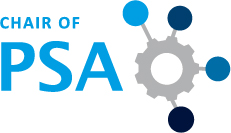Scientific news ticker february 2018
Holistic Migration Approach towards Cyber-Physical Production Systems (HoMoCPPS)
Februar2018 Industrial competitiveness today means shorter product lifecycles, increased product variety and shorter time-to-market. To face this challenge, manufacturing industry is forced to move towards intelligent manufacturing control systems that are dynamically adaptable to changing production environment and flexible to different processing tasks. With the envisioned Industry 4.0, digitalization and robotization will enhance flexibility and reconfigurability of production systems to faster react to changing market demands and customer requirements. Therefore, advanced automation solutions have been developed within the last decades, such as Multi-Agent Systems, Service-oriented Architectures, Cloud computing and Cyber-Physical Systems, to enable the decentralization and virtualization of the automation control pyramid towards the realization of the Smart Factory. Although automation in manufacturing is clearly changing, only very few industries have adopted advanced automation solutions in their production environment. Reasons are various and one of the key challenges is the lack of a well-defined and smooth migration path to distributing and virtualizing the automation pyramid.
Within IAF we are developing an holistic approach to support manufacturers in their migration towards cyber-physical production systems, envisioned by the Industry 4.0 paradigm, by providing them with a stepwise process and methodologies to implement the steps. The proposed approach is based on the existing migration strategies and engineering processes from other domains, revised and applied within the EU PERFoRM project to real manufacturing industries.
The smooth migration from existing production systems towards the cyber-physical production systems is a critical issue for the success of the fourth industrial revolution because of the risk related to the implementation of not well-known automation solutions. To cope with these uncertainties, the proposed process defines a set of migration steps to achieve the long-term vision of the industrial company, following an iterative and incremental approach. In the Industry 4.0 context, the long-term vision represents the target Smart Factory that the manufacturers intend to achieve in the long-run. To mitigate possible risks and obstacles due to the uncertainties coming from the market and technology areas, the migration path (Figure 1) towards the long-term vision is decomposed in intermediate short-term goals that will be reached one at time. Therefore, the proposed 5-phase process supports the stepwise and continuous migration to a more flexible, intelligent and innovative system by breaking down the path towards the long-term vision in migration solution steps that are identified, designed and executed within the five phases of the process.
Figure 1 - Definition of the migration path
The migration process in Figure 2 starts with the Preparation phase where the existing production system is analyzed and the long-term vision of the migration is defined. The second phase is the Options Investigation in which different migration solutions are collected and evaluated in order to identify the optimal migration steps towards the long-term vision. The selected solution option is detailed and tested in the Design phase, and then implemented and verified in the Implementation phase. The last phase represents the transformation of the current production environment with the Deployment of the new solution systems.
Figure 2 - 5-phase Migration Process
These migration process’ phases are supported by the interdisciplinary methodology of the Model-Based Systems Engineering (MBSE) that has been selected because of its capability to holistically represent any complex system, i.e. the current and the envisioned production system based on cyber-physical systems during the Design phase, and easily document in an unambiguous and semi-graphical form the different migration alternatives, which is particularly relevant in the Options Investigation phase (example in Figure 3), through specific tools and languages. In particular the System Modeling Language (SysML) is used to show how the conditions of the production system change with the introduction of new technologies, in terms of new interfaces with the legacy systems and new tasks required by the human operators and engineers that deal with the new configuration, by using pre-defined stereotypes and a specific color-code. Moreover, the MBSE supports also the trade-off analysis of migration solutions highlighting how the industry’s main goals and key performance indicators vary depending on the different solutions’ opportunities and constraints.
Figure 3 Example of evaluation of migration solution options in SysML
Links:
https://link.springer.com/chapter/10.1007/978-3-319-56345-9_8
http://ieeexplore.ieee.org/abstract/document/8088287/?reload=true
Contact: Ambra Calà M.Sc., apl. Prof. Dr.-Ing. habil. Arndt Lüder






